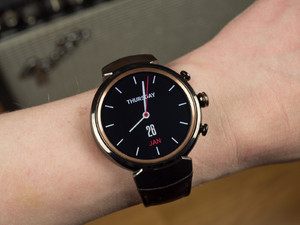Introduction
Have smartwatches reached an impasse? We've seen what the technology can do, and watched plenty of big-name mobile manufacturers release wearables, but lately it's felt like the time of the big smartwatch experiment has come and gone. Is it still possible for a smartwatch to generate consumer excitement?
Well, right now we're on the cusp of another new chapter in wearables, as Android Wear 2.0 gets ready to make its debut on commercially available hardware. And while that's sure to be plenty exciting on its own, before we get there we've got one more Android Wear 1.5 model from late last year to check out, as we take a look at the newest generation of the ASUS smartwatch lineup, the circular-screened ZenWatch 3.
Design
Arguably more so than is the case with phones, a smartwatch can live or die based on the quality of its design. For its first two models, ASUS went with standard rectangular watch faces, but still took the time to dress them up with curved glass, polished metal, and a body that did its best to look refined and professional.
With the ZenWatch 3, we see ASUS trying something new, while still retaining certain elements of that original style. The biggest change by far is the move to a circular screen, and considering the extent to which such models seem to dominate Android Wear sales, it's almost a little surprising it's taken ASUS this long to come around.
But even with that new shape, there's ample aesthetic hold-over here. One key element is the pairing of multiple metallic colors: silver and dark gray juxtapose against brassy, golden hues that give the watch a striking look. The exact match-ups will vary based on which of the three color configurations you go with, but none are bland, single-toned offerings.
Even though it doesn't look particularly rugged, the ZenWatch 3 still enjoys an IP67 rating against dust and water ingress.
Maybe the worst part of the ZenWatch 3's design is its strap. While replaceable, the strap connects to the watch at an awkward obtuse angle that seems to suggest it's built for those with very large wrists; the strap juts out the side, rather than following the contours of your arm. There's also an issue with the bands that are intended to hold the loose end of the strap in place; rather than do so, they have a tendency to slide out of place, rendering them quite useless. That's all a shame because the strap looks quite nice – it's just a bit lacking in terms of refinement and functionality.
Maybe the worst part of the ZenWatch 3's design is its strap. While replaceable, the strap connects to the watch at an awkward obtuse angle that seems to suggest it's built for those with very large wrists; the strap juts out the side, rather than following the contours of your arm. There's also an issue with the bands that are intended to hold the loose end of the strap in place; rather than do so, they have a tendency to slide out of place, rendering them quite useless. That's all a shame because the strap looks quite nice – it's just a bit lacking in terms of refinement and functionality.
Display
ASUS is making a big break from tradition with its move to a circular screen, and not everyone's going to feel about that the same way. On one hand, the round display on the ZenWatch 3 makes the wearable look substantially more like a standard wristwatch, possibly helping to improve user acceptance. That said, a square screen is arguably a better use of surface area (at least in terms of UI design), and we're sure the old look still has plenty of fans.
Even with that big change, the display still has a lot in common with the panel from the ZW2: we're looking at another AMOLED component and while resolution is higher here, differences in screen size (here, giving us a 1.39-inch display) mean that pixel density is very much in the same ballpark – 278 pixels per inch with the ZW2, vs. 287 for the ZW3.
By default, the screen is nice and bright, with five brightness levels and an auto mode, and you'll also find a brightness-boost option available if you're still struggling to see things in really sunny outdoor conditions.
In order to get the most out of your watch, you may want to keep the ZenWatch 3's always-on mode engaged. That reduces watch face complexity when you're not actively interacting with the watch (removing the second hand and dimming the screen, for instance), while still letting you see the time. Even with the efficiency of AMOLED, though, that still takes a big toll on battery life, and you may want to disable it to maximize time between charges.
In order to get the most out of your watch, you may want to keep the ZenWatch 3's always-on mode engaged. That reduces watch face complexity when you're not actively interacting with the watch (removing the second hand and dimming the screen, for instance), while still letting you see the time. Even with the efficiency of AMOLED, though, that still takes a big toll on battery life, and you may want to disable it to maximize time between charges.














No comments:
Post a Comment